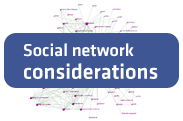 Social networking gives professionals and enthusiastic members of the public a great way to connect and share information about scientific or cultural topics.
Social networking gives professionals and enthusiastic members of the public a great way to connect and share information about scientific or cultural topics.A niche social network can benefit small, grassroots projects as well as large institutions, achieving many objectives simultaneously. A social network allows members to e.g., exchanging information, making personal connections, fostering dialog and awareness on a topic, as well as fundraising or promoting products and services.
Here are some tips and considerations for getting started…
Use existing sites.
Establish a presence on the main networks your audience is already using — e.g., via a Facebook page, Twitter account, LinkedIn group, other established online communities, and soon, Google+. These systems do a lot.
Start a blog.
If you have not already, start a blog. Your organization’s staff can write articles, or your can recruit independent bloggers and launch a blog network with between 3-20 independent bloggers. The world of blog networks is not yet saturated, and a common platform is great for both bloggers and the host organization. A blog provides a core of interesting content which helps anchor a social network.
Consider your objectives.
What are your goals? Educating the public, connecting professionals or enthusiasts, learning more about your constituents and their wants, fundraising or promoting products and services, driving membership, rallying support for a cause, providing online customer/member support, or simply keeping up with the Joneses? And, what’s the value of those outcomes in financial or intangible terms?
Reality check.
Launching a social network is expensive, and the benefits may not be financial. Market research firm Hypatia Research found in 2011 that only 25% of companies that launch social media have a positive return on their investment, and of those, the return was 0.5-2% ROI. (N>400 executives and employees at companies using customer-facing social media platforms.)
Plan features.
What kinds of features will your target community want? What features do you need that don’t exist in existing or inexpensive networks? See last week’s post about Ravelry and ExhibitFiles for ideas on features. You might draft a succinct social network policy which will keep interactions positive, civil and legal, but not over-police.
Most major platforms have virtually identical features, but they differ in their overall ease of use, and ease of launch.
Plan resources.
According to Bryan House, VP of marketing for Acquia (a company which provides support and hosting for the Drupal system), most social networks require the following three roles:
- Community Manager – This person nurtures and fosters participation. This includes routine tasks like removing spam, and subtle tasks that maintain a positive vibe in the community. If you have a blog network, the community manager recruits your bloggers, makes sure your bloggers are happy, encourages them, advocates for them within your organization, and promotes new posts on FB, Twitter, and other networks. At a minimum, this is 20% FTE, more if they write blog posts. — In the long term, this can be your biggest expense.
- Designer and CSS developer - This is the person who creates the themes for your pages, has an eye for a sensible user interface, and creates the CSS templates which display your site. Some designers also do CSS, but more often this is a team of two people. Usually system adminstrators are poor designers. Typically, there’s a constant stream of needs for new CSS.
- Dev/Ops – This is a new generation of system administrator. They are responsible for the code and infrastructure. This is a more technical role than a typical webmaster, but many wemasters may be able to do it. If you expect a lot of traffic, the person should understand multiple-server architectures and how to optimize and cache content. This role is not needed if you use a full-featured commercial service.
This all gets costly in staff time, or outside consultants and companies. More complex sites also have extra developers work on the site.
Also, hosting is a bigger deal with social networking, so expect to pay. The difference is that customized content takes more server resources than anonymous visitors. While a typical web server might be able to serve a million generic web pages a day, you might only get 1-10% of that volume for signed-in users who are looking at personalized profiles and streams.
Choose a platform.
There are hundreds of options for software. They range from hosted services, to free or commercial software which runs on your own servers. You will almost exclusively want a system hosted at a dedicated hosting facility (the cloud) because it’s more reliable than running on your local infrastructure.
Each software platform has tradeoffs.
Continue to the next post to look at software options… >>
source: Idea.org